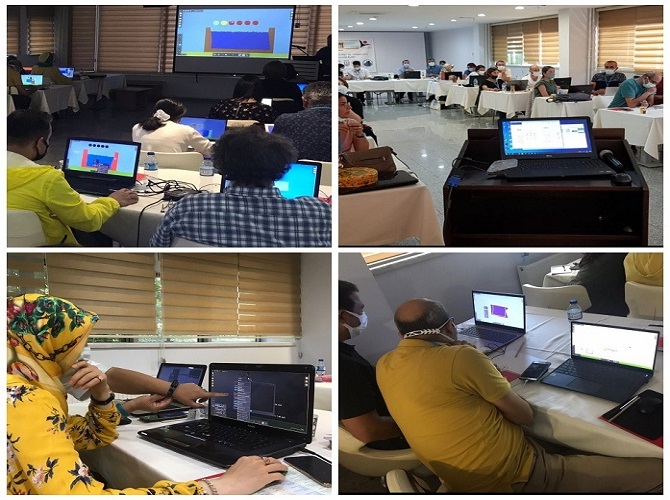
Physics Teachers' Opinions on Algodoo Training
Abstract
Full Text:
Download PDFReferences
Akdağ, F. T., & Güneş, T. (2018). Using Algodoo in computer assisted teaching of force and movement unit. International Journal of Social Sciences and Education Research, 4(1), 138-149. https://doi.org/10.24289/ijsser.337236
Aydın-Günbatar, S. (2019). Fenomenolojik araştırma (Olgu Bilim) yöntemi. (Ed: H. Özmen & O. Karamustafaoğlu). İçinde Eğitimde Araştırma Yöntemleri. s. 293-316, Ankara: Pegem Akademi.
Batuyong, C. T., & Antonio, V. V. (2018). Exploring the effect of PhET interactive simulation- based activities on students’ performance and learning experiences in electromagnetism. Asia Pacific Journal of Multidisciplinary Research, 6(2), 121-131. https://oaji.net/articles/2017/1543-1536135372.pdf
Çelik, H., Sarı, U., & Harwanto, U. N. (2015). Evaluating and developing physics teaching material with Algodoo in virtual environment: Archimedes' principle. International Journal of Innovation in Science and Mathematics Education, 23(4), 40-50.
Çoban, A. (2021). Algodoo for online education: impulse and momentum activities. Physics Education, 56(2), 025017. https://doi.org/10.1088/1361-6552/abd1e9
Çoramık, M., & Ürek, H. (2021). Calculation of kinetic friction coefficient with Phyphox, Tracker and Algodoo. Physics Education, 56(6), 065019. https://doi.org/10.1088/1361-6552/ac1e75
Creswell, J. W. (2013). Qualitative inquiry and research design: Choosing among five approaches (Third edition). New York: Sage. https://books.google.com.tr/books/about/Qualitative_Inquiry_and_Research_Design.html?id=OJYEbDtkxq8C&redir_esc=y
Dinçer, S., & Güçlü, M. (2013). Effectiveness of using simulation in computer aided learning and new trends in science education: A meta-analysis study article. International Journal of Human Sciences, 10 (Special Issue), 35-48.
Euler, E., & Gregorcic, B. (2019). Algodoo as a microworld: informally linking mathematics and physics. In: Pospiech, G., Michelini, M., Eylon, BS. (eds). Mathematics in Physics Education, 355-385. Springer, Cham. https://doi.org/10.1007/978-3-030-04627-9_16
Euler, E., Prytz, C., & Gregorcic, B. (2020). Never far from shore: productive patterns in physics students’ use of the digital learning environment Algodoo. Physics Education, 55(4), 045015. https://doi.org/10.1088/1361-6552/ab83e7
Gregorcic, B. (2015). Exploring Kepler’s laws using an interactive whiteboard and Algodoo. Physics Education, 5(5), 511-515. https://doi.org/10.1088/0031-9120/50/5/511
Gregorcic, B., & Bodin, M. (2017). Algodoo: a tool for encouraging creativity in physics teaching and learning. The Physics Teacher, 55(1), 25-28. https://doi.org/10.1119/1.4972493
Hırça, N., & Bayrak, N. (2013). Sanal fizik laboratuarı ile üstün yeteneklilerin eğitimi: Kaldırma kuvveti konusu. Genç Bilim İnsanı Eğitimi ve Üstün Zeka Dergisi, 1(1), 16-20. https://dergipark.org.tr/tr/download/article-file/479139
Jimoyiannis, A, & Komis, V. (2001). Computer simulations in physics teaching and learning: a case study on students' understanding of trajectory motion. Computers & Education, 36(2), 183-204. https://doi.org/10.1016/S0360-1315(00)00059-2
Kabadayı, H. İ., & Tanrıseven, I. (2022). A Case Study on Investigation of The Orientation Training Program Implemented in Science and Art Centers. The Journal of Academic Social Sciences, 10(130), 215-234.
Kabigting, L. D. C. (2021). Computer simulation on teaching and learning of selected topics in physics. European Journal of Interactive Multimedia and Education, 2(2), e02108. https://doi.org/10.30935/ejimed/10909
Karamustafaoğlu, O. (2012). How computer-assisted teaching in physics can enhance student learning. Educational Research and Reviews, 7(13), 297-308. https://doi.org/10.5897/ERR11.272
Kirmizigül, A. S. (2021). Algodoo for Interactive Learning: Effects on Students' Achievement and Motivation towards Science. Shanlax International Journal of Education, 9(4), 352-358. https://doi.org/10.34293/education.v9i4.4195
Moore, E. B., Chamberlain, J. M., Parson, R., & Perkins, K. K. (2014). PhET interactive simulations: Transformative tools for teaching chemistry. Journal of Chemical Education, 91(8), 1191-1197. https://doi.org/10.1021/ed4005084
Özdemir, E., & Çoramık M. (2021). The use of Algodoo in optics teaching. ISPEC 7th International Conference on Social Sciences & Humanities, September 18-19, Muş, Turkey. https://www.researchgate.net/profile/Erdogan-Oezdemir/publication/354691202_The_Use_of_Algodoo_in_Optics_Teaching/links/6152c3f5522ef665fb658f6c/The-Use-of-Algodoo-in-Optics-Teaching.pdf
Özer, İ. E., & Canbazoğlu Bilici, S. (2021). The effect of engineering design-based Algodoo activities on students’ design skills and academic achievement. Hacettepe University Journal of Education, 36(2), 301-316. https://doi.org/10.16986/HUJE.2020062006
Özmen, H., & Karamustafaoğlu, O. (Eds) (2019). Eğitimde Araştırma Yöntemleri. Ankara: Pegem Akademi. https://doi.org/10.14527/9786052417867
Solvang, L., & Haglund, J. (2021). How can GeoGebra support physics education in upper-secondary school—a review. Physics Education, 56(5), 055011. https://doi.org/10.1088/1361-6552/ac03fb
Taibu, R., Mataka, L., & Shekoyan, V. (2021). Using PhET simulations to improve scientific skills and attitudes of community college students. International Journal of Education in Mathematics, Science, and Technology, 9(3), 353-370. https://doi.org/10.46328/ijemst.1214
Turan-Güntepe, E., & Dönmez-Usta, N. (2022). Use of educational technologies in learning environment: Algodoo in the framework of technology acceptance model. Sivas Cumhuriyet University Educational Sciences Institute Journal, 1(1), 19-29.
URL-1, http://www.algodoo.com (07.11.2021)
Walsh, T., (2017). Creating interactive physics simulations using the power of GeoGebra. The Physics Teacher, 55, 316-317. https://doi.org/10.1119/1.4981047
Yunzal Jr, A. N., & Casinillo, L. F. (2020). Effect of physics education technology (PhET) simulations: evidence from stem students’ performance. Journal of Education Research and Evaluation, 4(3), 221-226
DOI: https://doi.org/10.17509/jsl.v6i1.49285
Refbacks
- There are currently no refbacks.
Copyright (c) 2023 Gökhan Sontay, Orhan Karamustafaoğlu

This work is licensed under a Creative Commons Attribution-ShareAlike 4.0 International License.


Jl. Dr. Setiabudhi 229 Bandung 40154, West Java, Indonesia











